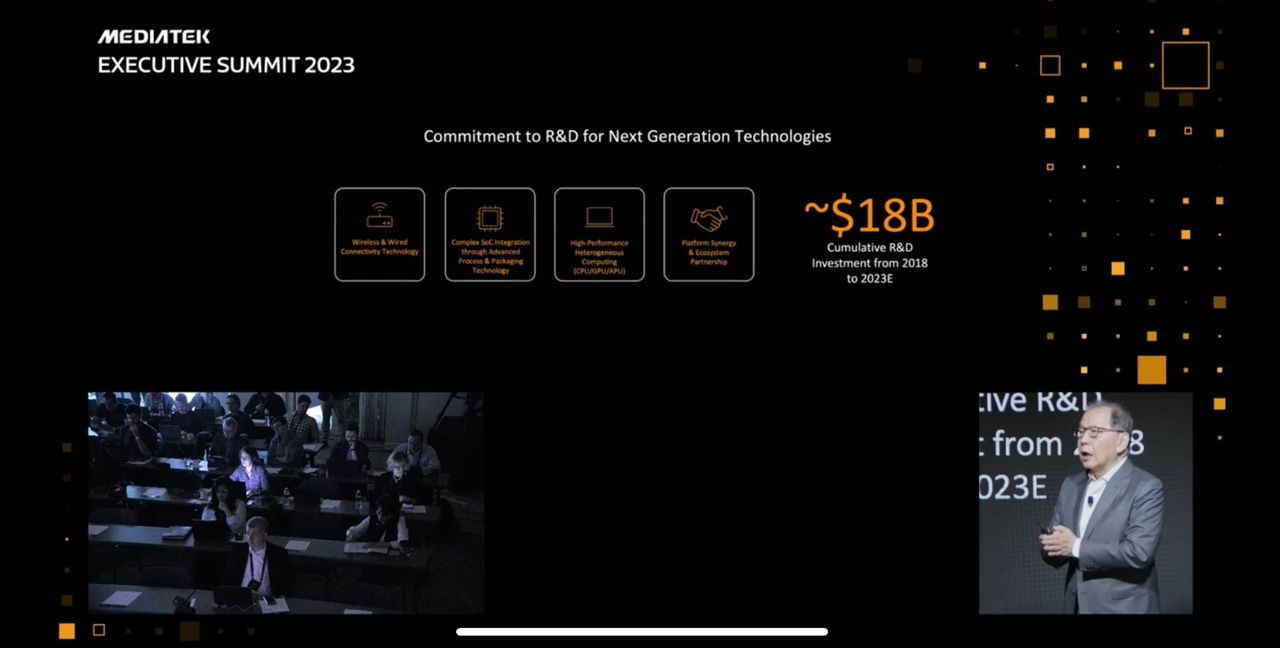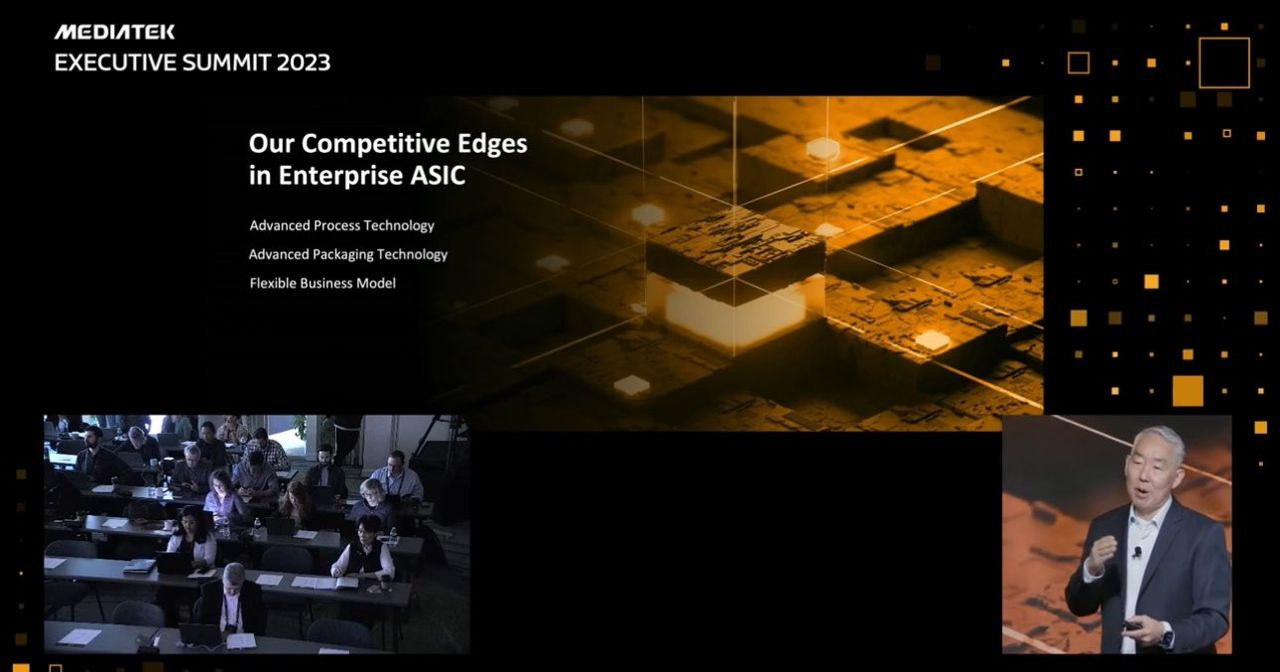- MediaTek held its annual executive summit in Laguna Niguel, California, recently.
- Key announcements emphasized on the company’s premium AI-driven and custom SoC (ASICs) strategy.
- The new connectivity solutions from Wi-Fi 7 chips to 5G and 5G RedCap thin modems underlined its IoT strategy and momentum.
- Other highlights included key partnerships and design wins – Meta for AR headset, NVIDIA for automotive and ARM for smartphones.
Counterpoint analysts attended MediaTek’s annual executive summit in Laguna Niguel, California, recently, spending time with key company executives CEO Rick Tsai, CFO David Ku, Corp VP Vince Hu, CTO Kevin Jou, SVP JC Hsu, GM & VP Marketing Finbarr Moynihan and partners and customers. The keynotes delivered centered around MediaTek’s incredible progress over the last five years and what is in store for the next five years.

WATCH: MediaTek Executive Summit 2023: AI Across Segments To Drive Business Growth
Last five years:
- MediaTek has raised its profile and performance over the last five years.
- The company’s revenues are up 2x, gross margins have increased by around 48%, and marquee partnerships and product announcements have gone up.
- MediaTek’s performance in “handsets”, its largest revenue segment, has been healthy since the pandemic and onset of the 5G era, leading the market in terms of unit volume share (see here: Smartphone AP/SoC Market Share by Quarter).
- More than 2 billion MediaTek chipset-powered devices are being shipped every year.
- MediaTek has spent nearly $18 billion in R&D over the last five years, helping it advance in areas of on-device AI and connectivity, and diversify into newer areas such as auto, wearables, 5G FWA and Chromebooks.

Next Five Years:
- MediaTek has laid out its key focus areas for the next five years, and obviously, they revolve around “Ubiquitous data processing (AI) and ubiquitous transmission (“fast connectivity 5G, Wi-Fi 7, NTN”)
- MediaTek is focusing on “Ubiquitous AI” to power advanced silicon compute needs across smartphones, automotive, XR, enterprise, cloud and industrial applications.
- The company has also been heavily focusing on the custom silicon (ASIC) market.

- MediaTek’s ASIC business is one of its less talked about success stories of working with multiple clients across multiple applications. For example, Sony for PlayStation VR2, Sony Premium Headset WH-1000XM5, Logitech, Juniper Networks Networking chip, Kontron SOM, BARCO and Advantech gateways.
- The company shipped its One Billionth Consumer ASIC this year with a more than 80% increase in design wins in 2023.
- MediaTek expects 200% revenue growth in the next two years for Edge AI custom ASIC chips.
- One of the key announcements at the summit was MediaTek’s partnership with Meta to build custom ASIC for Meta’s future AR glasses.
- This rides upon the successful design win in Sony’s PSVR2 (see here: XR Headset Market Share by Quarter )

- The new flagship Dimensity 9300, where MediaTek has taken a significant leap (see here: MediaTek Strengthens Premium Push With Gen AI Capabilities ), was among the most discussed topics.
- The company’s tight partnership with ARM and adoption of the ARM Total Compute Solution 23 (see here: Arm Platform TCS23 Sets Benchmark to Power Advanced, Holistic Mobile Computing Experiences) has helped it bring to the surface significant performance from its flagship SoC, taking on Qualcomm’s Snapdragon 8 Gen 3.
- The company believes its third-generation flagship SoC, the Dimensity 9300, will garner over $1 billion in revenues.
- vivo’s new flagship smartphone X100 is the first device to sport the Dimensity 9300. Launched in the China market, its initial reviews are super-encouraging.
- There was a discussion about how the company would get paid for AI and for improving AI models. For now, it is higher ASPs from its hardware. But it is early in the AI journey and things could change. The entire tech industry is exploring how it will monetize the generative AI wave.
- The key takeaway was MediaTek’s AI strategy with its seventh-generation APU which can handle up to 33 billion parameters LLM, much more than the competition.
- The company is also working on AI software tools, stack and ecosystem partners to allow OEMs and partners to leverage the compute capability via its NeuroPilot Stack.


- The foundry diversification strategy continues. Taiwan-based MediaTek has a strong relationship with Taiwan-based TSMC. It will continue to focus on leading-node production within TSMC. However, it is open to further diversification and US contracts are on the table.
- The company is excited about its solutions for the automotive segment. MediaTek has partnered with NVIDIA for automotive with each company playing to its strengths. For MediaTek, this means providing cellular connectivity including 5G, Wi-Fi and infotainment solutions. The company emphasized this is a high-ASP, 3nm solution to support the latest in connectivity and high-end gaming (think ray tracing). The company is focused on the China EV market, which is already the largest market in the world and also the most competitive. MediaTek has ambitions to eventually have an ADAS solution.
- The Chromebook market has been a blue-ocean opportunity for MediaTek to enter the PC market. The company believes it is going to be a natural progression to the Arm-based AI PC market in the coming years.
- In IoT, the company unveiled its M60 5G RedCap modem (see here: Big Role for 5G RedCap in 5G Evolution, Massive IoT Adoption) targeting smartwatches, bands and lightweight AR devices.
- Also announced were two Filogic Wi-Fi 7 (see here: White Paper: Growing 5G+Wi-Fi RF Complexity Demands Innovative, Advanced & Tightly Integrated RFFE Solutions) chipsets targeting global broadband service providers’ Ethernet gateways. These solutions will also service IoT router applications.
Wrapping up:
- MediaTek has spelled out a clear vision and roadmap focusing on AI and ASICs to propel growth across different applications.
- The ASIC strategy is working well to power compute in the IoT domain, whereas branded silicon is doing well in the handsets domain.
- MediaTek will have its work cut out though on building ecosystem and developer traction when it comes to AI success across silicon.

